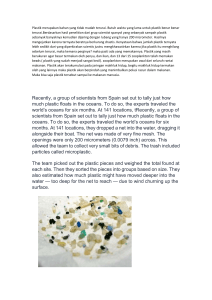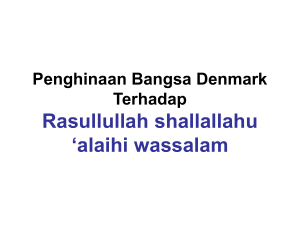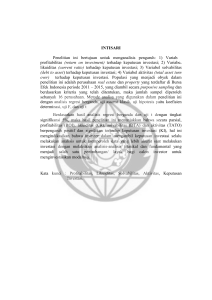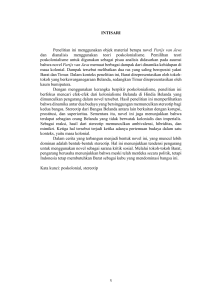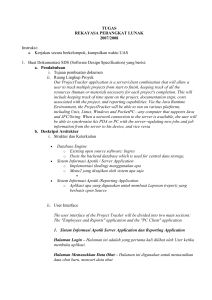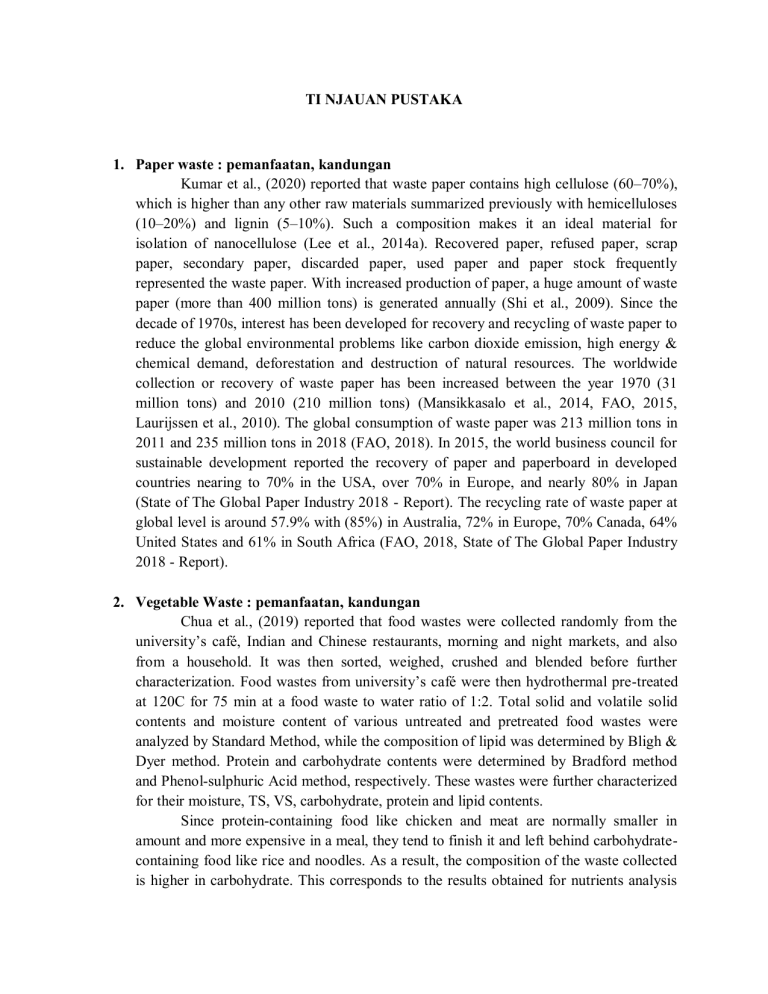
TI NJAUAN PUSTAKA 1. Paper waste : pemanfaatan, kandungan Kumar et al., (2020) reported that waste paper contains high cellulose (60–70%), which is higher than any other raw materials summarized previously with hemicelluloses (10–20%) and lignin (5–10%). Such a composition makes it an ideal material for isolation of nanocellulose (Lee et al., 2014a). Recovered paper, refused paper, scrap paper, secondary paper, discarded paper, used paper and paper stock frequently represented the waste paper. With increased production of paper, a huge amount of waste paper (more than 400 million tons) is generated annually (Shi et al., 2009). Since the decade of 1970s, interest has been developed for recovery and recycling of waste paper to reduce the global environmental problems like carbon dioxide emission, high energy & chemical demand, deforestation and destruction of natural resources. The worldwide collection or recovery of waste paper has been increased between the year 1970 (31 million tons) and 2010 (210 million tons) (Mansikkasalo et al., 2014, FAO, 2015, Laurijssen et al., 2010). The global consumption of waste paper was 213 million tons in 2011 and 235 million tons in 2018 (FAO, 2018). In 2015, the world business council for sustainable development reported the recovery of paper and paperboard in developed countries nearing to 70% in the USA, over 70% in Europe, and nearly 80% in Japan (State of The Global Paper Industry 2018 - Report). The recycling rate of waste paper at global level is around 57.9% with (85%) in Australia, 72% in Europe, 70% Canada, 64% United States and 61% in South Africa (FAO, 2018, State of The Global Paper Industry 2018 - Report). 2. Vegetable Waste : pemanfaatan, kandungan Chua et al., (2019) reported that food wastes were collected randomly from the university’s café, Indian and Chinese restaurants, morning and night markets, and also from a household. It was then sorted, weighed, crushed and blended before further characterization. Food wastes from university’s café were then hydrothermal pre-treated at 120C for 75 min at a food waste to water ratio of 1:2. Total solid and volatile solid contents and moisture content of various untreated and pretreated food wastes were analyzed by Standard Method, while the composition of lipid was determined by Bligh & Dyer method. Protein and carbohydrate contents were determined by Bradford method and Phenol-sulphuric Acid method, respectively. These wastes were further characterized for their moisture, TS, VS, carbohydrate, protein and lipid contents. Since protein-containing food like chicken and meat are normally smaller in amount and more expensive in a meal, they tend to finish it and left behind carbohydratecontaining food like rice and noodles. As a result, the composition of the waste collected is higher in carbohydrate. This corresponds to the results obtained for nutrients analysis in Fig. 1(b). Pre-processing wastes are mainly vegetables and fruits that contain a high amount of cellulose fibers. Hence, these wastes are solely complex carbohydrate. As such, food waste hydrolysate after hydrothermal pretreatment of solid food wastes has a higher content of carbohydrate, protein, and lipid 3. Plastic polypropylene (PP) waste: pemanfaatan, kandungan Ciri-ciri plastik jenis ini biasanya transparan tetapi tidak jernih atau berawan, keras tetapi fleksibel, kuat, permukaan berlilin, tahan terhadap bahan kimia, panas dan minyak, melunak pada suhu 140°C (Arif, 2018). Kurniawan & Yulianto (2020) melaporkan bahwav polypropylene merupakan salah satu jenis termoplastik. Plastik jenis ini bisa digunakan untuk perekat termoplastik dalam pengolahan papan partikel. Polypropylene masuk kedalam jenis plastik olefin dan polymer dari propylene. Diantara material plastik lainnya, PP (Polypropylene) memiliki kerapatan yang paling rendah, yaitu berkisar antara 0.855-0,946 gr/cm3 serta titik leleh yang tinggi (165 – 170 °C) sedangkan HDPE (high density polyethylene) memiliki kerapatan 0,941- 0,970 gr/cm3 serta titik leleh (127-135°C) dan kerapatan LDPE (low density polyethylene) 0,910-0,940 gr/cm3 serta titik leleh 115°C. Polypropylene merupakan jenis plastik yang dapat di daur ulang sehingga memiliki potensi sebagai matriks dalam pembuatan komposit papan partikel. Melihat sifat plastik yang tidak mudah terurai secara biologis dapat menyebabkan dampak buruk bagi lingkungan,cara terbaik yaitu memanfaatkannya menjadi produk lain. Pada pembuatan papan partikel komposit, ukuran partikel juga mempengaruhi terhadap kekuatan papan komposit jika ukuran partikel seragam maka bahan penyusun papan komposit akan saling mengikat dan menghasilkan kualitas papan partikel yang jauh lebih baik. Jun & Juwono (2010) melaporkan bahwa identifikasi dengan Fourier Transform Infrared (FTIR) menunjukkan bahwa PP daur ulang komersial mengandung campuran unsur polyethylene (PE) yang tidak terdapat pada PP murni dan PP daur ulang. Hasil uji tarik dan uji kekerasan menunjukkan tidak ada perubahan yang signifikan antara PP murni dan PP daur ulang. Di sisi lain, hasil uji tarik PP daur ulang menunjukkan bahwa kuat tarik lebih rendah 22,1% daripada PP murni, modulus Young turun 8,1%, dan strainat-break berkurang secara drastis sebesar 65,7%. Uji kekerasan pada PP daur ulang komersial menunjukkan bahwa kekerasan relatif tidak berubah. Pengamatan permukaan dengan Scanning Electron Microscope (SEM) memperlihatkan PP daur ulang komersial memiliki permukaan yang relatif lebih datar dengan ukuran butir lebih kecil dibandingkan dengan permukaan PP murni, yang menunjukkan bahwa bahan PP daur ulang komersial lebih brittle dibandingkan PP daur ulang. Hasil ini mendukung hasil uji tarik dimana terjadi penurunan signifikan pada strain-at-break PP daur ulang komersial.
